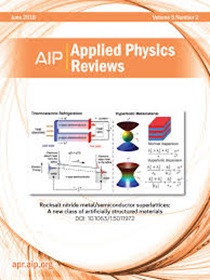可持续能源转换中电催化剂设计的先进理论建模方法
IF 11.9
1区 物理与天体物理
Q1 PHYSICS, APPLIED
引用次数: 0
摘要
电化学反应是实现碳中和和可持续社会的能量转换和存储的关键,而最佳的电催化剂对于其工业应用至关重要。理论建模方法,如密度泛函理论(DFT)和分子动力学(MD),在原子和分子水平上有效地评估电化学反应机理和电催化剂性能。然而,其固有的算法局限性和大规模系统的高计算成本导致实验观察与计算模拟之间存在差距,制约了电催化剂设计的准确性和效率。结合机器学习(ML)是加速电催化剂发展的一种很有前途的策略。ML-DFT框架建立了准确的性质-结构-性能关系,以预测和验证新型电催化剂的性质和性能,从而深入了解反应机理。基于ml的方法也加速了MD和DFT的求解。此外,整合机器学习和实验表征技术代表了一种前沿的方法,可以深入了解工作条件下的结构、电子和化学变化。本文综述了DFT的发展及其在各种电化学能量转换中电催化剂设计中的应用现状。本文将总结其潜在的物理基础、应用进展和挑战。最后,提出了未来的研究方向和展望,以指导新型电催化剂的设计,为可持续能源革命服务。本文章由计算机程序翻译,如有差异,请以英文原文为准。
Advanced theoretical modeling methodologies for electrocatalyst design in sustainable energy conversion
Electrochemical reactions are pivotal for energy conversion and storage to achieve a carbon-neutral and sustainable society, and optimal electrocatalysts are essential for their industrial applications. Theoretical modeling methodologies, such as density functional theory (DFT) and molecular dynamics (MD), efficiently assess electrochemical reaction mechanisms and electrocatalyst performance at atomic and molecular levels. However, its intrinsic algorithm limitations and high computational costs for large-scale systems generate gaps between experimental observations and calculation simulation, restricting the accuracy and efficiency of electrocatalyst design. Combining machine learning (ML) is a promising strategy to accelerate the development of electrocatalysts. The ML-DFT frameworks establish accurate property–structure–performance relations to predict and verify novel electrocatalysts' properties and performance, providing a deep understanding of reaction mechanisms. The ML-based methods also accelerate the solution of MD and DFT. Moreover, integrating ML and experiment characterization techniques represents a cutting-edge approach to providing insights into the structural, electronic, and chemical changes under working conditions. This review will summarize the DFT development and the current ML application status for electrocatalyst design in various electrochemical energy conversions. The underlying physical fundaments, application advancements, and challenges will be summarized. Finally, future research directions and prospects will be proposed to guide novel electrocatalyst design for the sustainable energy revolution.
求助全文
通过发布文献求助,成功后即可免费获取论文全文。
去求助
来源期刊

Applied physics reviews
PHYSICS, APPLIED-
CiteScore
22.50
自引率
2.00%
发文量
113
审稿时长
2 months
期刊介绍:
Applied Physics Reviews (APR) is a journal featuring articles on critical topics in experimental or theoretical research in applied physics and applications of physics to other scientific and engineering branches. The publication includes two main types of articles:
Original Research: These articles report on high-quality, novel research studies that are of significant interest to the applied physics community.
Reviews: Review articles in APR can either be authoritative and comprehensive assessments of established areas of applied physics or short, timely reviews of recent advances in established fields or emerging areas of applied physics.
 求助内容:
求助内容: 应助结果提醒方式:
应助结果提醒方式:


